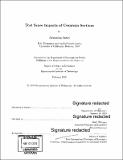Test score impacts of Cesarean sections
Author(s)
Fahey, Alexandra(Alexandra Marie)
Download1103441880-MIT.pdf (6.489Mb)
Other Contributors
Massachusetts Institute of Technology. Department of Economics.
Advisor
Heidi Williams.
Terms of use
Metadata
Show full item recordAbstract
Despite extensive discussion in the medical community on the benefits and risks of C-sections and at what rate they should occur, a potentially crucial question remains unanswered - what are the long-term developmental impacts of birth method on children of low-risk births? In particular, how do C-sections influence measures such as childhood test scores? I address this question amid empirical complications - confounding factors that influence birth method may also impact postnatal outcomes - using a variety of methods. First, using basic linear regressions with a validated set of controls and a sample of mother-child pairs from the NLSY79, I find a 1% decline in average PIAT scores for children when born via C-section. Effects are strongest for math and reading comprehension. Increasing the flexibility of the model through propensity score matching, I find that if a child is unnecessarily born through C-section, their score will be 1.3 points lower than their vaginal birth counterpart. Then, in an attempt to mitigate omitted variable bias, I use the approach of Oster (2017) and incorporate movements in the estimated treatment effects and in the R² to define an identified set that is robust to selection on unobservables. With this, I estimate effects of between -0.2 and -1.3 points of C-sections on average PIAT scores. However, the identified sets at the subject-level contain zero, and thus I cannot reject the null hypothesis of no effects for all measures. Finally, an instrumental variables approach using a metric defined as the difference in (standardized) mother's height and (standardized) child's birth length supports the results of negative effects. However, inconclusive attempts to validate the exclusion restriction leave this method as something that should be explored further before conclusions can be made.
Description
Thesis: S.M., Massachusetts Institute of Technology, Department of Economics, 2019 Cataloged from PDF version of thesis. Includes bibliographical references (pages 43-49).
Date issued
2019Department
Massachusetts Institute of Technology. Department of EconomicsPublisher
Massachusetts Institute of Technology
Keywords
Economics.